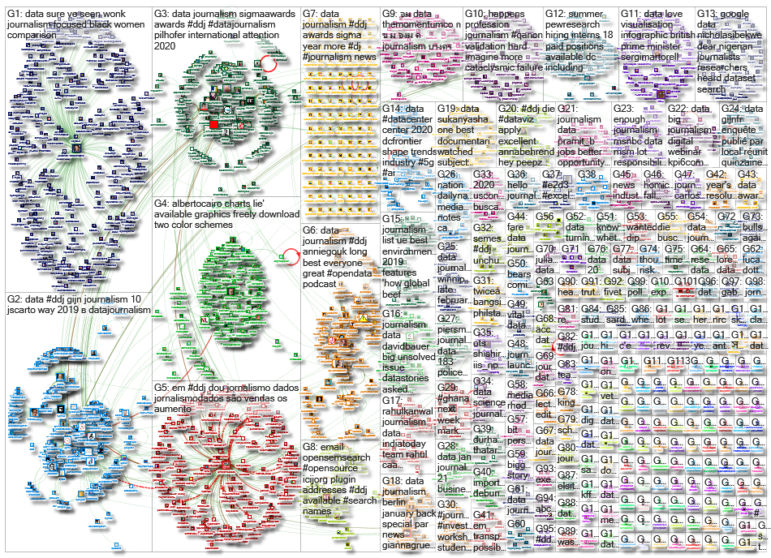What’s the global data journalism community tweeting about this week? Our NodeXL #ddj mapping from January 6 to 12 finds the New York Times exposing partisan editing in school textbooks, a new data science platform from Turkey, Delayed Gratification’s infographic on how to become the British prime minister, Alberto Cairo making his graphics available for free, and an analysis of fact-checks of Brazilian President Jair Bolsonaro.
Politicization of School Textbooks
The New York Times analyzed some of the most popular social studies textbooks used in California and Texas. It found that the textbooks were customized for students in different states, and their contents sometimes diverge in ways that are shaded by partisan politics.
Texas is rewriting school textbooks to fit a Fox News worldview. And the filter bubbling of American life is now being advanced through our schools.
A sickening report, full of revelations, by the brilliant @DanaGoldstein.
— Anand Giridharadas (@AnandWrites) January 12, 2020
How to Be a British Prime Minister
The United Kingdom’s electorate seems to have a type for their choice of prime minister, according to an infographic by Delayed Gratification. Want the top job in British government? The data analysis suggests that if you are a white male, English by birth, and educated in a private school, you have good odds.
Love this visualisation of data. Infographic: How to be British prime minister: https://t.co/apVWKk0Fn4 pic.twitter.com/pq70fK4kJ9
— Sergi Martorell (@SergiMartorell) January 7, 2020
Bolsonaro’s False Statements Analyzed
According to speeches checked and compiled by Aos Fatos, Brazil’s President Jair Bolsonaro made 608 false or misleading statements in his first 12 months in office, which is an average of 1.6 per day. This means that of the 1,067 phrases fact-checked in 2019, 56% contained some degree of distortion. May and June had the highest concentration of misleading statements, when topics such as the environment and weapons were highlighted in his presidential speech.
O contador de declarações de @jairbolsonaro é capaz de dar diagnósticos precisos sobre a estratégia de comunicação do Planalto. Isso revela subjetividades dessa interação: quando menos assessorado e quando ele mesmo tem de se expor, mais declarações falsas dá o presidente. https://t.co/XUHY9XI0CD
— Tai Nalon (@tainalon) January 9, 2020
How Far Is Your Bishop from Nando’s?
Writer and clergyman Fergus Butler-Gallie shared a fun graphic showing how far bishops would have to walk from their cathedrals to reach a Nando’s restaurant. Unfortunately, priests from Truro and Bath and Wells would have to walk more than five hours to reach one.
Have you, like me, ever wondered how long it would take the Diocesan Bishops of the Church of England to walk from their cathedrals to a Nando's if they were peckish? Wonder no more. pic.twitter.com/Wtb6MIXaku
— Fergus Butler-Gallie (@_F_B_G_) January 6, 2020
2019 Data Year in Review
Enrico Bertini and Moritz Stefaner, hosts of Data Stories podcast, released a special end-of-the-year episode for 2019 – instead of the usual one guest, it featured 13 guests who work with data or design. Each person talked about developments in data visualization around the world and the central challenges.
What's a big unsolved issue in data journalism? @datastories asked me, my answer: https://t.co/whkpQT5VMP pic.twitter.com/9GqW3QXXtl
— David Bauer (@davidbauer) January 7, 2020
Free Graphics from How Charts Lie
Alberto Cairo, Knight Chair in Visual Journalism and author of “How Charts Lie,” recently made most of the graphics in his latest book available to download for free. He also made a few edits to the first print edition. Anyone who wants to receive cards containing these edits, contact Cairo here.
'How Charts Lie' graphics freely available to download and in two color schemes (for now): https://t.co/gbvgWo3DwW
Also, don't forget the edits page: https://t.co/WLoyx6xjwP#dataViz #infographics #ddj pic.twitter.com/QmLWkK7veJ
— Alberto Cairo (@AlbertoCairo) January 8, 2020
Best of Nathan Yau’s Graphics
Statistician Nathan Yau usually looks at datasets from various angles before making one to two graphics per angle. He recapped the most popular topics/datasets and their accompanying charts published last year, including How Couples Meet and Stay Together, How Sleep Patterns Change with Age, and How Much Money People Make.
An inspiring 'performance review' recap of the data viz work by @flowingdata: https://t.co/y2qf2qoeGz pic.twitter.com/7WztJsiBrW
— Matt Stiles (@stiles) January 1, 2020
Data Science Platform
Melda.io is a web-based cloud-native data science platform, an initiative from Turkey. You can create data analysis projects with R, python, publish your work, interact, and co-create with others.
A new version of https://t.co/35WhumiZk0 with a better look and new features… https://t.co/bvoCdlpY7B
— Servet Ahmet Çizmeli (@CizmeliServet) January 7, 2020
A Look at the Universal Credit System
Daily Post took an in-depth look at the people benefiting under the new Universal Credit welfare system that is replacing six “legacy” benefits in the UK. It also explores the flaws in the system, and links with homelessness and food banks.
Everyone should look at @AnnieGouk's universal credit project – great example of long-form data journalism with collaboration from local newsrooms on case studies https://t.co/CdQQVKuPIS
— Michael Goodier (@michaelgoodier) January 6, 2020
Investigating Public Data in Brazil
Just launched in Brazil: Núcleo Jornalismo is a journalistic project that aims to be an independent vehicle that will investigate public data to bring more transparency to the government, political debate, and public policy. The initiative is supported by Volt Data Lab.
Está no ar a página do NÚCLEO! Somos um veículo jornalístico independente que fará investigações a partir de dados públicos. Vem saber mais sobre o nosso projeto e conhecer nossa equipe: https://t.co/y4CaEQy6Hq
— Núcleo Jornalismo (@nucleojor) January 6, 2020
Thanks again to Marc Smith of Connected Action for gathering the links and graphing them. The Top Ten #ddj list is curated weekly.
 Eunice Au is GIJN’s program coordinator. Previously, she was a Malaysia correspondent for Singapore’s The Straits Times, and a journalist at the New Straits Times. She has also written for The Sun, Malaysian Today, and Madam Chair.
Eunice Au is GIJN’s program coordinator. Previously, she was a Malaysia correspondent for Singapore’s The Straits Times, and a journalist at the New Straits Times. She has also written for The Sun, Malaysian Today, and Madam Chair.

